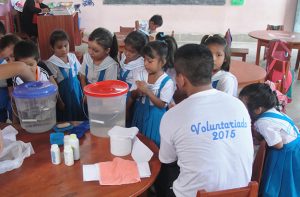 Photo: Volunteers from the Program AguaSalud in a rural kindergarten classroom in Bagua Grande, Peru
Photo: Volunteers from the Program AguaSalud in a rural kindergarten classroom in Bagua Grande, Peru
Development is far from glamorous. It’s hard work, takes a lot of patience, and involves a lot more listening than doing. In 2015, a colleague and I worked in the Amazonas Region of Peru with Students for International Development (SID) on a community development project in the health sector. The project, AguaSalud, was piloted the year prior with the goal of improving hygiene practices like hand washing among students aged three to 12 through practical, hands-on (pun intended) workshops. In 2014, SID also installed a water tank at the pilot school in order for the kids to actually be able to practice those good behaviours learned in the workshops.
While journal-keeping is not a habit of mine, I did jot down a few things we learned that summer. I dug them out to see if they still ring true after having lived here full-time for almost a year. (They do.)
1. Different groups want and need different things
While the us-them discourse is one we are taught (and seek) to avoid when working in a community other than our own, it’s much easier to ignore the multiplicity of wants and needs within that population, though sometimes their difference is subtle. Talk to the mayor, you get one suggestion; the ministry of health, another; the teachers and parents, a multitude of suggestions and ideas. Further down the totem pole, so to speak, the demands become easier to meet, but more short-sighted. This is where the listening factor comes in big time. While there’s no easy way (or maybe even no way at all) to take into account all of these POVs, it is so important to hear out all of the stakeholders and boil the information down to find commonalities.
2. We didn’t necessarily know best, but we did have something to contribute
Anyone who’s taken Professor Rivas’s class, is certainly familiar with the question: “Who tells the story? And why?” This theme can be applied to all sorts of situations, and international development is no exception: “Who knows best? And why?” The answer? The people who live there, of course. However, what we did discover is that we had something to offer: perspective. An external take on an internal problem goes a long way in working out potential solutions to a problem. What we discovered was that we were able to offer an outsider’s POV – not a better one, but a different one. That, accompanied by access to research did not replace but rather complemented the community’s goals.
3. Our project was the tip of the iceberg
Getting to the root of a problem is easier said than done. We dove in with an idea, and came up for air a few weeks into the project only to realize the problem was leagues deep. Our program offered a step of Maslow’s Hierarchy without the provision of its predecessor secured: the city we were in, Bagua Grande, has serious problems with the provision of water. A few weeks into our project there was no water in the whole city and wouldn’t be for a few more weeks. The reasons for it were many: poor infrastructure damaged by the rain, for one, and the inability for the municipality to collect, store, and sanitize water enough water quickly enough, another. When there is water at all, its distribution is irregular. The only reason we had water in our own apartment is that we could afford to purchase tanks from a guy who had a spring on his private property. This was a big hurdle for us, personally and professionally: how could we possibly offer hand washing workshops to kids who don’t have adequate access to water neither at school nor at home?
Though the water problem was temporary, it is recurring. The penny dropped one day when we were pitching the program to a school and they, in short, told us it was useless to give workshops unless we could provide them with water. While our project wasn’t wrong, it was just skimming the surface of a much bigger issue – we didn’t have the time nor resources to change direction at the time (and, arguably, nor should we have) but this “iceberg” revelation caused us to both modify both our program and our approach.
4. Tangible vs. intangible dispute is irreconcilable
When you have little, it’s hard to think long-term. The desire for physical, tangible things – a new water tank and soap, for example – over the intangible – life skills like hand washing, for example. SID’s initial idea was that the workshops would be the “meat” of the project and the infrastructure a bonus, but as we phased out the infrastructure part our the program, we realized that what (almost) everyone was excited about was the latter not the former. This desire for immediate results is something we all have, but it all too often inhibits the achievement of long-term goals. In my experience, there has always been tension between the tangible and the intangible, and may always be.
Photo: Taken by the author.